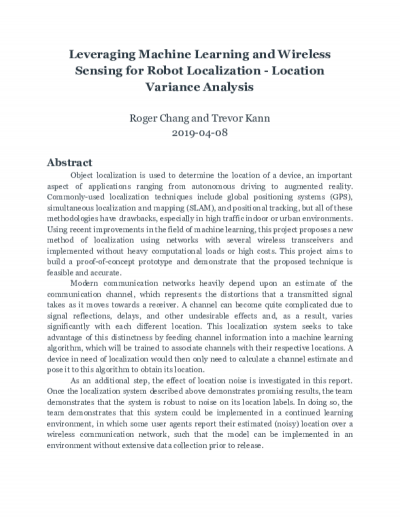
Description
Object localization is used to determine the location of a device, an important aspect of applications ranging from autonomous driving to augmented reality. Commonly-used localization techniques include global positioning systems (GPS), simultaneous localization and mapping (SLAM), and positional tracking, but all of these methodologies have drawbacks, especially in high traffic indoor or urban environments. Using recent improvements in the field of machine learning, this project proposes a new method of localization using networks with several wireless transceivers and implemented without heavy computational loads or high costs. This project aims to build a proof-of-concept prototype and demonstrate that the proposed technique is feasible and accurate.
Modern communication networks heavily depend upon an estimate of the communication channel, which represents the distortions that a transmitted signal takes as it moves towards a receiver. A channel can become quite complicated due to signal reflections, delays, and other undesirable effects and, as a result, varies significantly with each different location. This localization system seeks to take advantage of this distinctness by feeding channel information into a machine learning algorithm, which will be trained to associate channels with their respective locations. A device in need of localization would then only need to calculate a channel estimate and pose it to this algorithm to obtain its location.
As an additional step, the effect of location noise is investigated in this report. Once the localization system described above demonstrates promising results, the team demonstrates that the system is robust to noise on its location labels. In doing so, the team demonstrates that this system could be implemented in a continued learning environment, in which some user agents report their estimated (noisy) location over a wireless communication network, such that the model can be implemented in an environment without extensive data collection prior to release.
Modern communication networks heavily depend upon an estimate of the communication channel, which represents the distortions that a transmitted signal takes as it moves towards a receiver. A channel can become quite complicated due to signal reflections, delays, and other undesirable effects and, as a result, varies significantly with each different location. This localization system seeks to take advantage of this distinctness by feeding channel information into a machine learning algorithm, which will be trained to associate channels with their respective locations. A device in need of localization would then only need to calculate a channel estimate and pose it to this algorithm to obtain its location.
As an additional step, the effect of location noise is investigated in this report. Once the localization system described above demonstrates promising results, the team demonstrates that the system is robust to noise on its location labels. In doing so, the team demonstrates that this system could be implemented in a continued learning environment, in which some user agents report their estimated (noisy) location over a wireless communication network, such that the model can be implemented in an environment without extensive data collection prior to release.
Details
Title
- Leveraging Machine Learning and Wireless Sensing for Robot Localization - Location Variance Analysis
Contributors
- Chang, Roger (Co-author)
- Kann, Trevor (Co-author)
- Alkhateeb, Ahmed (Thesis director)
- Bliss, Daniel (Committee member)
- Electrical Engineering Program (Contributor)
- Barrett, The Honors College (Contributor)
Date Created
The date the item was original created (prior to any relationship with the ASU Digital Repositories.)
2020-05
Subjects
Resource Type
Collections this item is in
